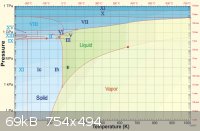Fusionfire
Hazard to Others
  
Posts: 219
Registered: 8-7-2011
Member Is Offline
Mood: No Mood
|
|
< 0°C possible with NH4NO3 + H2O?
Apologies if this is an obvious question, but is it possible to achieve temperatures below the freezing point of pure water with the endothermic
reaction between ammonium nitrate and water, if you add antifreeze to the water and chemically depress its FP?
What if you physically depressed the FP of water instead by lowering the ambient pressure of the reaction? Is it possible to reach 200K by mixing
NH4NO3 + H2O under 1 microbar pressure?
Is the optimum cooling achieved when you mix precisely the amount of NH4NO3/water as solubility dictates? E.g. at 0°C the solubility of NH4NO3 in
water is 118g/100ml. So mix 118g of NH4NO3 with 100g of water. Any further addition of water will not produce any further heat absorption.
|
|
|
kristofvagyok
National Hazard
   
Posts: 659
Registered: 6-4-2012
Location: Europe
Member Is Offline
Mood: No Mood
|
|
200K is really low, but if you calculate in Celsius then you can easily go under 0 by simply mixing ammonium-nitrate and water like here: http://www.youtube.com/watch?v=G3S4YvhhAic
Another: http://archief.bc-enschede.nl/wgrassroots/vakken/scheikunde/...
Also the most efficient cooling could be done if you directly mix breaked ice and solid ammonium salts -without water- with a large "breaker" til it
turn into a "mush" -I don't know that is it the best world for that, but it will be the most coolest as possible.
I have a blog where I post my pictures from my work: http://labphoto.tumblr.com/
-Pictures from chemistry, check it out(:
"You can’t become a chemist and expect to live forever." |
|
|
vmelkon
National Hazard
   
Posts: 669
Registered: 25-11-2011
Location: Canada
Member Is Offline
Mood: autoerotic asphyxiation
|
|
I have seen a demo where a beaker is on a wet table. When you make your NH4NO3 solution, the temp goes below 0 °C and the beaker stays stuck to the
table.
I'm pretty sure you will never reach 200 K (-73.15 °C). There is a certain temperature where the solution would just freeze sort of like NaCl and
water's limit is -18 °C and below that temp, it just freezes. That is why NaCl is useless in very cold temp.
|
|
|
Fusionfire
Hazard to Others
  
Posts: 219
Registered: 8-7-2011
Member Is Offline
Mood: No Mood
|
|
Sorry, my mistake I wasn't paying attention to the phase diagram when I posted. I can be quite blind sometimes and didn't see the big "Solid" on the left of the 200K, 1 microbar point 
Anyway, it looks like the lowest temperature pure liquid water can exist is at the triple point of 207.5 MPa and -22°C. Of course this diagram only
applies for pure water.
Lower temperatures of liquid water are possible with a variety of antifreezes.
http://en.wikipedia.org/wiki/Antifreeze
-37.8°C with 60-70% glycerol and water
http://en.wikipedia.org/wiki/Antifreeze_protein
Or more interestingly:
http://www.redorbit.com/news/science/1799347/new_antifreeze_...
-100F = -73°C !
Obviously as the proportion of water decreases you have to take into account the "thermal mass dead weight" of non-water components that will reduce
the heat absorbed per g of antifreeze + water mixture added.

|
|
|
vmelkon
National Hazard
   
Posts: 669
Registered: 25-11-2011
Location: Canada
Member Is Offline
Mood: autoerotic asphyxiation
|
|
From http://www.redorbit.com/news/science/1799347/new_antifreeze_...
The text says
"UAF graduate student and project collaborator Todd Sformo found that the Alaska Upis beetle, which has no common name, first freezes at about -18.5
°F in the lab and survives temperatures down to about -104 °F."
therefore, it freezes at -28 °C, not -75 °C.
PS : I wish these guys would stop using the °F. I thought that scientists use the metric system.
|
|
|
Fusionfire
Hazard to Others
  
Posts: 219
Registered: 8-7-2011
Member Is Offline
Mood: No Mood
|
|
I did see that, I was wondering if it freezes solid at -18.5 °F, or by "freeze" they mean it stops moving, but it's body fluids are still liquid (in
effect hibernating).
|
|
|